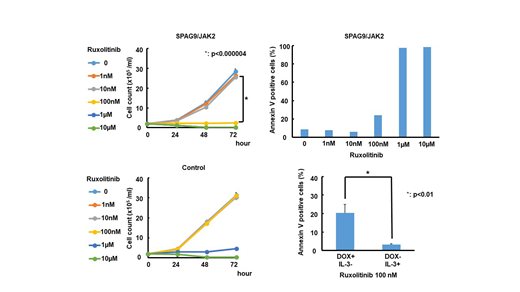[Background and aim of this study]
Philadelphia chromosome-like acute lymphoblastic leukemia (Ph-like ALL) is a distinct subtype of B-ALL with poor prognosis. JAK2 related fusion genes with diverse partner genes have been identified in this subtype, especially in adolescent and young adults (AYA). Previously, we identified SPAG9-JAK2 fusion gene in 14-year-old boy with Ph-like ALL (Kawamura M, et al. Genes Chromosomes Cancer. 2015). JAK2 fusion protein is putative therapeutic target of Ph-like ALL with JAK2 rearrangement, so it should be clarified whether JAK inhibitor is effective for the leukemic cells with JAK2 fusion genes. In this study, we performed functional analysis of SPAG9-JAK2 to establish molecular targeting therapy for the patients with SPAG9-JAK2.
[Materials and Methods]
Full length of SPAG9-JAK2 cDNA was cloned into retroviral construct with Tet-On system. Then, Ba/F3 cells, which are IL-3 dependent murine pro B-ALL cells, were transduced with retroviral vector to establish Ba/F3 cells expressing SPAG9-JAK2 (Ba/F3-SPAG9-JAK2) under doxycycline (DOX) dependent manner. Once Ba/F3-SPAG9-JAK2 was established, cells were analyzed whether IL-3 independent growth was achieved. To determine whether aberrant activation of JAK-STAT pathway achieved by SPAG9-JAK2, activation of JAK-STAT pathway was evaluated by western blot. In addition, gene expression analysis using Mouse Genome 430 2.0 Array was performed for comprehensive analysis of gene expression profile related to SPAG9-JAK2. Finally, in cytotoxic assay, proliferation of Ba/F3-SPAG9-JAK2 was assessed under the media with various concentrations of ruxolitinib (JAK inhibitor, RUX).
[Results and discussions]
The expression of SPAG9-JAK2 in Ba/F3 cells under DOX dependent manner was confirmed by western blot. Ba/F3-SPAG9-JAK2 could proliferate without IL-3 in contrast to Ba/F3 cells (p<0.0001), suggesting that SPAG9-JAK2 had the IL-3 independent proliferation activity of Ba/F3 cells. Western blot revealed that constitutive phosphorylation of tyrosine residue of SPAG9-JAK2, Stat5, and Stat3, suggesting that constitutive activation of JAK2-STAT pathway contributes to IL-3 independent proliferation activity.
Gene expression analysis revealed that, in Ba/F3-SPAG9-JAK2, expression of 187 genes among 45,037 probes was increased (log 2 ratio, ≥2.0) and the expression of 371 genes was decreased (log 2 ratio, ≤2.0), compared with those in Ba/F3. Pathway analysis revealed that the expression level of several genes related to type II interferon signaling pathway, p53 signaling pathway, Il4 receptor signaling pathway and G1 to S cell cycle control in Ba/F3-SPAG9-JAK2. In detail, Stat1, Stat2, Ptpn6, Irf1 and Cxcr4 were significantly up-regulated and Cdkn2a and Cdkn2b were significantly down-regulated in Ba/F3-SPAG9-JAK2. These findings were in accordance with activation of JAK-STAT pathway and aberrant growth promotion of Ba/F3-SPAG9-JAK2.
Considering that JAK inhibitors could block constitutive phosphorylation of SPAG9-JAK2, RUX might block the IL-3 independent proliferation of Ba/F3-SPAG9-JAK2. Cytotoxic assay revealed that 100nM of RUX suppressed the proliferation of Ba/F3-SPAG9-JAK2 completely (p<0.00001), although 100nM RUX didn't show any effect on Ba/F3. Annexin V assay also determined that 100 nM RUX induced more apoptosis in Ba/F3-SPAG9-JAK2 than Ba/F3 (p<0.01). These findings suggest that RUX abolishes the proliferation activity of SPAG9-JAK2 selectively and is possibly effective for ALL with SPAG9-JAK2.
[Conclusion]
Although in vivo study is required, our in vitro study clearly demonstrated that RUX could be effective for the B-ALL patients withSPAG9-JAK2. Further studies are on-going to determine other therapeutic target of B-ALL with SPAG9-JAK2.
No relevant conflicts of interest to declare.
Author notes
Asterisk with author names denotes non-ASH members.


This feature is available to Subscribers Only
Sign In or Create an Account Close Modal